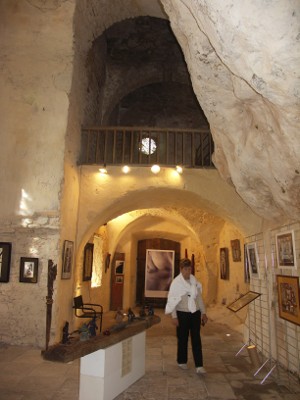Le Viaduc de Millau (Millau Viaduct) is a man-made wonder spanning a wondrous valley in the Massif Central of France.
The elegant multi-span cable-stayed bridge has linked the Causse Rouge and the Causse Larzac above the Tarn Valley since December 2004. Higher than the Eiffel Tower, the Millau Viaduct is the highest bridge in the world, a milestone in the history of concrete and an attraction in its own right.
But the geological upheaval that took place in this area millions of years ago, has influenced more than the bridge design and motorway route. The upheaval created limestone gorges, tablelands, caves, rocky outcrops, deep rivers and natural springs. It’s an area to explore for both its natural beauty and its clever adaptations by human beings.
The village of Millau is almost 400 metres above sea level, and almost 200 kilometres from the Mediterranean, but was originally under the sea. You can see the natural history on a grand scale or on a micro level.
One afternoon while eating charcuterie and sipping pastis in a little hut on a little vineyard with new friends Martine and Jean-Pierre, I was shown a fossilised mollusc they had found that afternoon near their natural spring, yet another of the many legacies of the natural history of the area.
To take in the grand scale of the Millau Viaduct and its surroundings, I went driving with Martine and Jean-Pierre. It gave me the chance to explore villages like the semi-troglodytic Peyre, with a stunning view of the Viaduct, the caves of Roquefort and the abandoned village of Caves entre les deux Monts.
Walking also provided a close-up view of the Parc Naturel des Grand Causses. After a steep climb in a car, I took an 11km walk along an escarpment, the Corniches de la Jonte. I was overshadowed by huge outcrops of rock, several of them named after pottery styles (Vase de Chine, Vase de Sevres) and sometimes scarcely indistinguishable from the occasional ruined castle on neighbouring hillsides. Natural springs replenished my water supply en route, and I was over-flown by soaring members of a large colony of Griffon vultures, while crossing the Causse de Méjean plateau from the Tarn and Jonte Valleys
From a distance, I saw others engaging with rock-climbing, canoeing, cycling, fishing, pilgrim-trail walking and hang-gliding. Somewhere underground and out of my view were the cavers and speleologists.
My caving experiences were limited to those of the gastronomic variety. I took a tour of the caves at Roquefort, heavy with the smell of the blue-vein cheese and the mould-decayed bread which was the original source of the penicillium roqueforti.
The geology is critical to this famous cheese because a network of fleurines (fissures in the rock), which means that the caves are perfectly ventilated for the Roquefort. The fleurines maintain a temperature of 10º Celsius and 95% humidity all year round.
While the fromage de brebis (cheese made from the milk of the ewe) continues to flourish, deserted semi-troglodytic wine caves above Compeyre and Fontaneilles are now just part of the area’s patronomie (heritage).
Perfectly ventilated like the Roquefort caves, the Caves entre les deux Monts provided excellent conditions for storing wine over many centuries but succumbed to competitive pressures over a hundred years ago. The caves are relatively hidden away, but they are being restored by the Parc Naturel des Grand Causses, so expect them to be more accessible in the future.
I left the colossal natural area via the Millau Viaduct itself. With my Griffon-eye view of the Tarn Valley and the many little huts dotted across the hillsides, I nostalgically zoomed in a particular hut, not much bigger than a pocket handkerchief, and recalled home-made wine, charcuterie and fossilised molluscs.
Fact file:
- Millau can be reached by the A75 motorway from Paris or Beziers. It can also be reached by train from Toulouse or Beziers.
- Millau is located in the départment (administrative area) of Averyon within the Midi-Pyrenees region.
- Excellent brochures are available from its regional tourist office.






